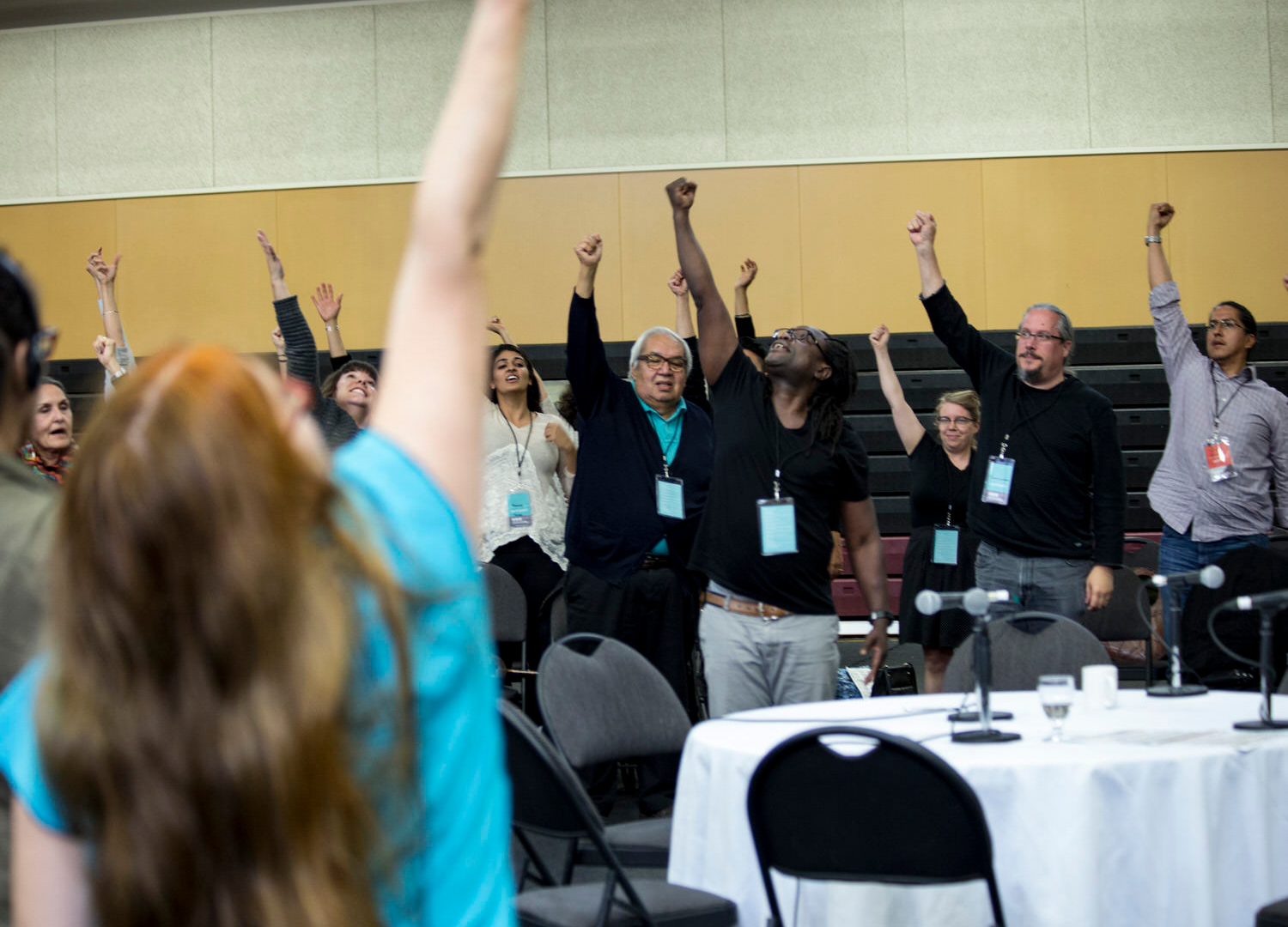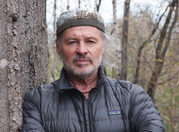 Casimiro Nhussi leading participants in movement during the
Casimiro Nhussi leading participants in movement during the
PC/Cp Gathering 2017 on Lekwungen territory.
Photo credit: Kirk Schwartz.
The heart of the Primary Colours/Couleurs primaires gathering was the large talking circle that brought together all the participants in the gymnasium. It was also the site of our formal ceremonies. And that is where the workshop on Re-wilding our Imaginations took place.
I was happy to present the idea of Re-wilding our Imaginations as a way to renew our relationships with the non-Indigenous world of art. I suggested that we start by considering the expression “retracing the footsteps of our Elders” (learning from the past in order to engage with the future).
We took inspiration from the work of Kanien’ke ah :ka Taïake Alfred, a political scientist and professor at the University of Victoria. And our soul-searching, which was of a serious nature due to ethical and aesthetic considerations, was magically enlightened by the presence and contributions of Vanessa Oliviera-Andreotti, my workshop co-host. A native of Brazil, she shared her viewpoints on ancient and modern-day practices in South America.
Moreover, although the gymnasium was abuzz with activity and the need for interpretation required us to be patient, as we listened to each participant’s contribution the dialogue was further enriched.
I have three main takeaways: (1) the importance of respect for the knowledge, know-how and knowing how to live together demonstrated by our Elders, particularly the incredible resilience of women, whose power is being passed on to the next generations; (2) the importance of telling Indigenous stories of art that take into account the “inter-American” nature of the entire continent, and; (3) the need, like with Wampum, to re-interpret our stories in light of present-day reality.
One way to translate our thoughts into action is through what I call staged rants. And so, at the end of the workshop, I put on my moccasins and bracelets and invited the group to follow me outside to the tall Songhees/Lekwungen totem poles, resplendent under the brilliant sunshine.
Forming a new circle, I invoked the memory of Grand Chief Kwakwaka’wakw Mungo Nakapankan Martin, who was born in Prince Rupert and who died in Victoria in 1962. Not only did he continue to hold potlatch ceremonies in defiance of the Indian Act, he also rekindled the memory of Indigenous songs and the great totem poles (he was a mentor to the Hunt brothers as well as Bill Reid). People still talk about his performance at the 1953 inauguration of the Royal British Columbia Museum, to which he gifted his famous Longhouse. Breaking a copper crest in two, he kept one half and threw the other half into the bay; well before the word reconciliation became fashionable, he pointed out that a lasting peace would be achieved only when the two halves were once again joined.
Accompanied by Vanessa, we approached the waterfall feature in front of the Centre and threw in copper pennies, a symbol of power. I then held up a small amulet of a copper killer whale purchased at the Museum and we concluded the beautiful afternoon by showing respect to our Elders with a performance of re-wilding our imaginations.
Guy Sioui Durand
Tsie8ei
8enho8en
Translated by Don Sugden, reviewed by Breanna Fabbro

Guy Sioui Durand is a Wendat (Huron) based in Wendake, Québec, Canada. He is a sociologist (PhD), art critic, independent curator, and performer (spoken word). He is specialized in contemporary Aboriginal art and contemporary art. Sioui Durand is curating the project Hommage aux Skywalkers/Ironworkers Mohawks from the event Rassemblement Internations d’Art Performance Autochtone (RIAPA) in Wendake this September 14-16, 2018. He is preparing the exhibition De Tabac, de Sauge et de Foins d’odeurs for the Joliette Museum of Art for winter 2019. Sioui Durand teaches "Initiation to Modern and Contemporary Aboriginal Art" at the Kiuna Native Institution, the only completely Aboriginal post-secondary institution.